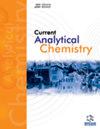XRD 在药物发现中的实用视角和作用:综述
IF 1.7
4区 化学
Q3 CHEMISTRY, ANALYTICAL
引用次数: 0
摘要
:生物物理技术包括在分子和细胞水平上研究生物系统以发现药物的各种方法。等温量热法、电子显微镜、X射线衍射(XRD)、电子显微镜、质谱分析、原子力显微镜、差示扫描量热法、表面等离子体共振和核磁共振等各种方法都是药物发现的重要技术。在这些技术中,X射线衍射被广泛应用于基于结构的药物发现,而FBDD(基于片段的药物发现)则被广泛应用于药物发现的不同阶段。XRD 被认为是确定生物大分子和多肽结构的最重要工具之一。XRD 的不断发展和进步改进了数据处理、收集、样品装载和提高吞吐量等各个方面。这一进步对于获得高分辨率的蛋白质和其他生物大分子晶体结构至关重要。从 XRD 中获得的结构是基于结构的药物发现和 FBDD 的核心。这篇综述文章重点介绍了生物物理技术的不同作用,特别强调了先进性、数据收集以及 XRD 在不同药物发现阶段的作用。本文章由计算机程序翻译,如有差异,请以英文原文为准。
Practical Perspectives and Roles of XRD in Drug Discovery: A Review
: Biophysical techniques include various methodologies applied in studying biological systems at the molecular and cellular level for the drug discovery process. Various methods like isothermal calorimetry, electron microscopy, XRD (X-ray diffraction), electron microscopy, mass spectrometry, atomic force microscopy, differential scanning calorimetry, surface plasmon resonance, and nuclear magnetic resonance are important techniques for drug discovery. Out of these techniques, XRD is widely employed in structure-based drug discovery, whereas FBDD (fragment-based drug discovery) is widely used in the different phases of drug discovery. XRD was considered one of the most important tools for structure determination of biomolecules and peptides. Consistent development and advancement in XRD improved the various aspects of data processing, collection, sample loading, and increased throughput. This advancement is crucial in obtaining highly resolved protein and other biomolecule crystal structures. The structure obtained from XRD forms the core of structure-based drug discovery and FBDD. This review article focuses on the different roles of biophysical techniques with special emphasis on advancement, data collection, and XRD's role in different drug discovery phases.
求助全文
通过发布文献求助,成功后即可免费获取论文全文。
去求助
来源期刊

Current Analytical Chemistry
化学-分析化学
CiteScore
4.10
自引率
0.00%
发文量
90
审稿时长
9 months
期刊介绍:
Current Analytical Chemistry publishes full-length/mini reviews and original research articles on the most recent advances in analytical chemistry. All aspects of the field are represented, including analytical methodology, techniques, and instrumentation in both fundamental and applied research topics of interest to the broad readership of the journal. Current Analytical Chemistry strives to serve as an authoritative source of information in analytical chemistry and in related applications such as biochemical analysis, pharmaceutical research, quantitative biological imaging, novel sensors, and nanotechnology.
 求助内容:
求助内容: 应助结果提醒方式:
应助结果提醒方式:


